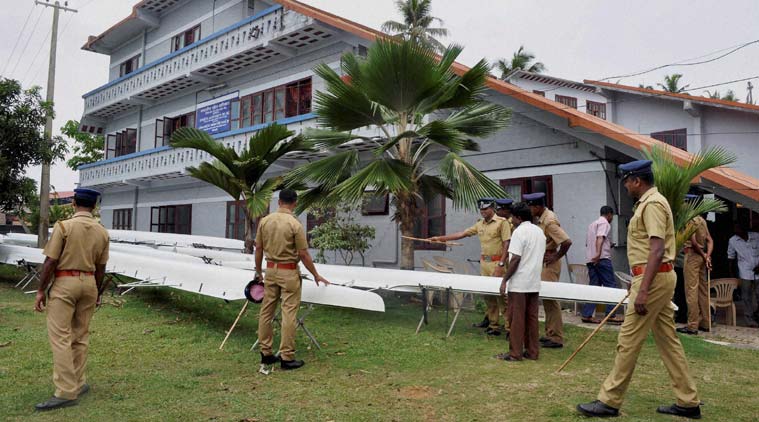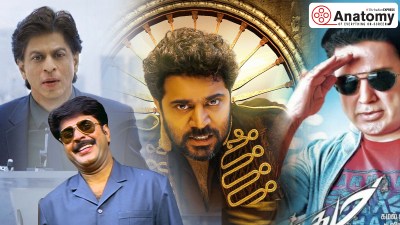- India
- International
Whose Shame is it Anyway?
The underlying problem is the battered state of Indian sports. Why do we still not have many non-cricketing icons and why do we continuously fail to produce sporting champions?
 Police at the SAI centre in Alappuzha (Source: PTI)
Police at the SAI centre in Alappuzha (Source: PTI)
By: Jyotsna Mohan Bhargava
We are a country of committees, cinema and cricket. Our answer to any problem is to launch a never-ending inquiry. The rest of our time is either spent tracking the ‘Khans’ or idolizing (and often) demonising MSD and gang.
Which is why, as the country debates whether Salman Khan’s bail is morally justified, the story of a suicide pact amongst four female athletes was swiftly demoted from headlines. One of the teenagers tragically died, and the remaining three are fighting for their lives. Predictably, a probe was immediately ordered as to why athletes training at a government run academy in Alappuzha, Kerala would take this extreme step. The institute claims the girls did this because they were taunted for drinking beer. Seriously? Relatives of the victim accuse coaches and seniors at the institute of both mental and physical harassment, to the extent of beating their child with a rowing oar.
This incident though, is just the tip of the iceberg. The underlying problem is the battered state of Indian sports. Why do we still not have many non-cricketing icons and why do we continuously fail to produce sporting champions? Consider this – Australia, with a population of 28 million, has won 138 Olympic golds. Even North Korea, which has competed in just 9 Olympics has won 14 golds. India, with all its 1.4 billion people, has won 9 of which 8 were in field hockey. Why?
Simply put, it is very difficult to become a world class sportsperson. The odds are too high and it requires sports infrastructure and training facilities that actually work. To naysayers, it’s not necessarily a lack of money; our 2015 Central Budget allocates Rs. 887 crore to sports and games for just this year. Add to this state level allocations.

Our apathy begins at the grass root level, in local fiefdoms like district and state level sports federations- de facto homes for our budding sportsmen and women. Barely six months ago, Hockey India’s High Performance Director complained about the turfs at NIS Patiala (ostensibly Asia’s largest sports institute), saying they were dangerous to play on. Even turfs in centers like Bhopal and Bangalore are considered extremely unsafe. Last heard, there is only one center available in the entire country for training our national team. Yet we wonder why we do not see the return of a golden era in hockey.
It is no different for other sports. We are in the midst of a great phase in badminton because people like Gopichand mortgaged their family house to start a private academy. Then there is an Abhinav Bindra who juggled between his own funds and a private trust to get India its first individual Olympic gold. Our boxers and wrestlers come from far more humble backgrounds, living in dingy hostels in Bhiwani and in traditional akharas in Sonipat. These days we are all gaga about Sim Bhullar, the first Indian origin player in the NBA. His name may be Indian but he was born in Canada, and he never trained in India. We have no right to claim ownership over him.
However, what we can claim to have is at least seventy recognized national sports federations in our country, each with its countless state and district level associations. According to the Centre for Public Policy Research, CPPR, nearly forty of these are run by politicians. Barring very few, have any of them ever delivered? Have we heard of a Taekwondo champion or someone excelling in cycling? The Supreme Court could not have spelled it out clearer; in 2013, it said politicians and businessmen heading sports bodies were only causing harm. But has anything changed? Jagdish Tytler headed the Judo Federation for more than 25 years. When it seemed he could not make himself any younger and there was an age barrier, he became a patron for life. What did he achieve for our country in these 25 years?
Then there is boxing. A sport that put us on the medal tally thanks to Vijendra Singh and Mary Kom, and today gives us hope every time we see an Indian in the ring. Turns out, our boxers’ “never give up” attitude clearly extends to those who run the sport as well! When his 12-year tenure as chairman of the Indian boxing federation ended, Abhay Chautala decided the bout was still in his corner.So despite indictment in a corruption scam, he elevated himself to the new post of president. This forced the world body to de-recognize the All India Boxing Federation and our boxers could not compete under the Indian flag.
The list is endless, the greed for power and money enormous. Our Archery Federation saw the same fate after its president of 40 years, V K Malhotra refused to step down. Not just our federations, its big daddy, even the Indian Olympic Association was suspended for several months on charges of corruption by the International Olympic Council. To top it all, Lalit Bhanot, after spending almost a year in jail for charges in the Commonwealth Games scam, came back where he left off – as the de facto head of the IOA! Go figure! His erstwhile boss Suresh Kalmadi performed just as admirably! He too was arrested for corruption and forgery in the scam, but not before ruling, or should I be saying, ruining Indian sports for more than two decades.
There can be no comparison to the coffers of the BCCI. Despite rumors and allegations of cash mismanagement, money still filters down; our cricketers are very well paid excluding their endorsement earnings. But other sports pay a heavy price for corruption, and just as importantly, immoral and incompetent sports administrators. In 2010, the chief coach of the women’s national hockey team was forced to resign after being accused of sexual harassment by a player. In the same year there were also allegations against the women’s weightlifting coach. Last year, a gymnastics coach was booked for allegedly harassing an athlete. The list is long.
Some years ago, several former sportsmen launched a drive to clean up Indian sports. Their intentions were honorable but the task not easy. Ironically, even a hockey legend like Pargat Singh was defeated by then 83 year old politician Vidya Stokes in the elections for Hockey India. That perhaps sums up the state of Indian sport: politicans rule, and everyone else is at their mercy.Many of us don’t actively support our children to take up a sport as a profession because there are very few like a Saina Nehwal who can defeat the system. But in rural India, success in sports can mean a better life. A life with some basic comforts that archers like Deepika Kumari hope to give their auto rickshaw driving father.
On a parting note, does anyone remember Sarwan Singh? He won a gold medal in athletics in the 1954 Asiad. It didn’t even get him a government job. He drove a taxi for 20 years and at the age of seventy had to till a farmer’s land to survive. I doubt if anyone has ever heard of Sita Sahu either; a multiple medal winner at the 2011 Special Olympics. In 2013, major media houses carried stories about her being forced to sell gol guppas to support her family. Two years later, she still does.
Soon, no one would have heard of these four teenagers from Kerala either.
Apr 26: Latest News
- 01
- 02
- 03
- 04
- 05








































